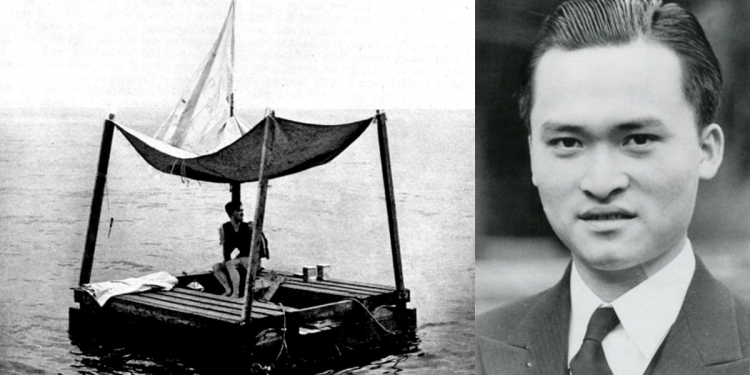In the midst of an endless ocean where the sky and the sea blend into a horizon an incredible tale of survival began. This is a story of a man who simply refused to give up. On November 23, 1942, The SS Benlomond was struck by a torpedo from a German submarine. On this ship was a man named Poon Lim. He was a simple Chinese seafarer who had now been cast adrift in the vast Atlantic Ocean.
Facing the unforgiving sea Lim chose to fight against nature’s might. The only person he could fall back on was himself. He started on his journey of survival which would last 133 agonizing days. This story, speaks volumes about the struggle he faced. Imagine the isolation, the constant uncertainty, and the brutal conditions he faced for what must’ve seemed like an eternity. This article explores the strength that people can gather when they’re up against some truly overwhelming challenges.
A Perilous Journey Begins

Credit: Creative Common License.
Poon Lim was a Second Mess Steward on this massive cargo ship, the Benlomond, cruising from Suez to New York via some pretty far-off places. The ship had this mix of officers from Britain and a mostly Chinese crew. They were sailing all alone, with no backup or escort, just cruising along.
On November 23, 1942, the Benlomond faced a sudden attack when a German submarine, U-172, fired two torpedoes at it. The ship was hit hard and chaos ensued. Lim, who was in his cabin at the time, quickly grabbed his life jacket and rushed to his boat station. However, he was swept overboard and was left struggling in the waves. As he emerged from the water, his heart sank as he looked around and saw only a handful of planks bobbing in the waves. In a desperate bid to stay afloat, he grabbed onto one of them and clung on tight, hoping and praying that he would be rescued soon. The ship sank within minutes, leaving Lim to face his fears alone.
After battling the waves for a few hours, Lim noticed a wooden life raft, which was a beacon of hope in the vast ocean. Soon after, he also spotted another raft in the distance with a few guys waving at him. Lim thought they were his shipmates and attempted to join them, but the problem was that his own raft had no oars. The two rafts drifted apart, which must have been a heart-wrenching moment for him. It must have been a terrifying and utterly heartbreaking experience for Lim to be stuck without any means to get closer to potential help.
The 133 Days of Survival

Credit: Creative Common License.
Lim had to make do with very little on that raft. About 45 liters of water, some hardtack (those super hard biscuits), chocolate, pemmican (a mix of meat and fat), flares, a flashlight, two smoke pots, and even some evaporated milk — all on a little raft lost in the big ocean. Oh, and not to forget the lime juice and massage oil, quite the odd survival kit.
At first, Lim stuck to the basics, eating what was there and drinking the water. But as days went by, he had to get pretty crafty. Fishing became a must, and he even started catching birds! He was crafting fishing gear out of random bits and pieces.
But the heartbreaking part is imagining him out there, not being a strong swimmer, and still fighting to survive. Tying himself to the boat in case he fell in, using the flashlight spring as a fishhook, and even making a knife from a pemmican can. And then, drying bird meat for jerky.
It’s both scary and impressive, to see someone make use of whatever they have on hand to survive in the middle of nowhere. Lim definitely turned that tiny raft into a floating survival kit!
Lim, with his makeshift fishing line and some leftover bird bits, managed to catch a shark as well. But here’s the scary part: when he tried to get it onto the raft, the shark attacked him! The guy had to use a water container to fight back and, in a surprising turn of events, he managed to beat the shark to death.
Imagine the desperation he felt when he sucked the blood from the shark’s liver to quench his thirst. It hadn’t rained, and he had run out of water. He even dried the shark’s fins in the sun.
Lim was all about making things work. He even crafted a skirt from a hessian bag and rigged his raft with a canopy. It was both protection from the sun and a way to collect rainwater. It’s like he turned that raft into a survival fortress against the elements!
A few days later, he spots a submarine and tries calling out for help, waving and shouting, but the crew just laughs and sails away. And it wasn’t just them. Even when cargo ships were in sight, Lim shouted for help in English, but no one gave him a hand. It’s both heart-wrenching and scary.
Lim believed they didn’t rescue him because he was Asian, maybe mistaking him for a Japanese sailor in trouble. It’s heartbreaking to think that despite his efforts, no one was willing to help him. And here’s the scary part—German U-boats had a trick, placing someone on a raft as a trap for rescue ships. That fear must’ve been terrifying for Lim, feeling like he was in danger even when seeking help.
There were moments of hope, like when U.S. Navy planes spotted him and even dropped a marker buoy! But, when a storm hit he was lost again. It’s like a rollercoaster of emotions—hope one moment and despair the next.
Lim, stranded at sea, started counting the days by tying knots in a rope. But as the days dragged on, he realized that counting them was not helping him survive. So, he started counting full moons instead, finding peace in the rhythm and continuity of the celestial cycles. This shift in approach helped him stay calm and focused, allowing him to navigate the rough waters with a clear head. His survival story is a testimony to the power of adaptability and resilience in the face of extreme adversity.
Rescue and Heroic Legacy
After months adrift, Lim finally spotted signs of land in April 1943. He could tell he was getting closer because the color of the ocean changed. It was a mix of relief and disbelief. He had drifted around 750 miles westward, and then, out of the blue, three Brazilian fishermen found him just off the coast of Pará, east of Salinas.
The state he was in could bring anyone to tears. Lim had lost a significant amount of weight, around 20 pounds, and was so weak that the fishermen had to help him off the raft. But after some good meals and care, when they landed him at Belém a few days later, he could walk again, even though he was still pretty weak.
The crazy part? Lim was the only survivor from the Benlomond. Everyone else, including the ship’s captain, Captain John Maul, and 43 crew members along with 8 gunners, unfortunately didn’t make it. It was both a relief and a heartbreak for him, surviving when everyone else had perished.
After a few weeks in a Brazilian hospital, Lim was feeling well enough to travel. The British Consul stepped in and organized his journey to Britain via Miami and New York. It’s like a mix of sadness and relief, finally finding safety after an incredibly tough journey at sea.
Beyond the Storm
After being rescued, Lim experienced a wide range of emotions. He was honored at a ceremony in New York, where the Acting British Consul delivered some incredible news: King George VI was going to award him the British Empire Medal! Lim’s exceptional bravery, strength, and resourcefulness during his dangerous voyage on the raft were praised. Additionally, Ben Line gave him a gold wristwatch as a token of appreciation for his incredible survival.
The Royal Navy even took notes from his experience and included it in their survival manuals. Lim’s story became part of these teachings, a testament to his unbelievable survival skills.
After the war, Lim wished to start anew in the United States, but there was a problem: the quota for Chinese immigrants was full. Luckily, with the help of Senator Warren Magnuson and Lim’s own fame, he got special permission and eventually became a citizen. Lim even tried to join the US Navy, but his application was turned down because of, believe it or not, flat feet!
But when Lim was told no one had ever survived longer on a raft, he simply said, “I hope no one will ever have to break that record.” It’s a mix of hope and fear. Although others have faced similar hardships at sea, nobody has surpassed Lim’s time on a life raft.
His incredible tale even inspired a novel. The writer Alfred Bester used Lim’s experience in his book “The Stars My Destination,” featuring a man stranded in space. It’s amazing to see how Lim’s story inspired creative minds!
Sadly, Lim’s journey came to an end in Brooklyn on January 4, 1991, at the age of 72. His legacy lives on through his incredible story of survival and endurance against all odds.












